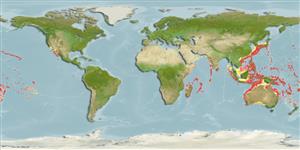Classification / Names
Common names from other countries
Main reference
Size / Weight / Age
Max length : 60.0 cm TL male/unsexed; (Ref. 4388); max. published weight: 11.0 kg (Ref. 4388); max. reported age: 8 years (Ref. 4388)
Environment
Marine; benthopelagic; oceanodromous (Ref. 51243); depth range 50 - 700 m (Ref. 58488)
Climate / Range
Tropical, preferred ?; 40°N - 36°S, 40°E - 110°W
Distribution
Indo-Pacific and Eastern Central Pacific: East Africa to California, USA. References to Taractichthys longipinnis in the Indo-Pacific are considered misidentifications of this species. Highly migratory species, Annex I of the 1982 Convention on the Law of the Sea (Ref. 26139).
Countries | FAO areas | Ecosystems | Occurrences | Introductions
Short description
Dorsal
spines
(total): 0;
Dorsal
soft rays
(total): 33-37;
Anal
spines: 0;
Anal
soft rays: 26 - 28;
Vertebrae: 44 - 46. Body covered with large hard scales, each with a spine. Anterior lobes of dorsal and anal fins high, but changing in shape and height with growth; both fins covered with scales, not depressible in a groove. There are no areas without scales above nor behind the eye. Adults without a lateral line. Attains 60 cm SL.
IUCN Red List Status (Ref. 115185)
Threat to humans
Harmless
Human uses
Fisheries: commercial
More information
ReferencesAquacultureAquaculture profileStrainsGeneticsAllele frequenciesHeritabilityDiseasesProcessingMass conversion
Tools
Special reports
Download XML
Internet sources
Estimates of some properties based on models
Phylogenetic diversity index
PD50 = 0.7500 many relatives (e.g. carps) 0.5 - 2.0 few relatives (e.g. lungfishes)
Trophic Level
4.2 ±0.6 se; Based on size and trophs of closest relatives
Resilience
Medium, minimum population doubling time 1.4 - 4.4 years (tmax=8)
Vulnerability
High vulnerability (55 of 100)
Price category
